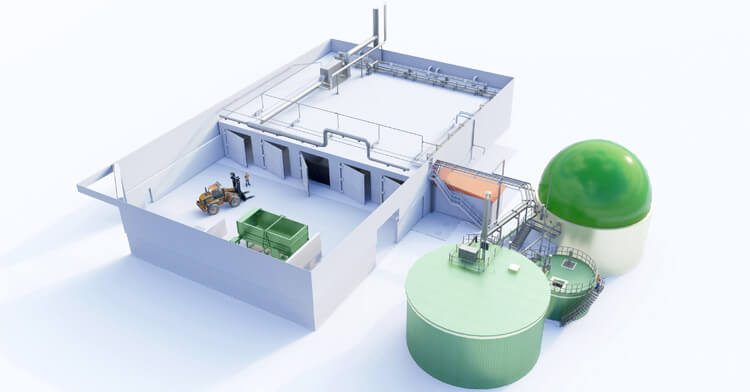Draygon’s wastewater treatment process was tested by an independent group for effectiveness in certain applications. Specifically, McKnight Transport Ltd; County Down, Northern Ireland, planned to develop an Anaerobic Digestion Plant, through which the primary feedstock would be a combination of food waste and chicken litter. This process would produce biogas which would be exploited for energy recovery using CHP technology. The end product of Anaerobic Digestion (AD) is Digestate.
They also planned to develop a nutrient reprocessing center at this facility. This center would comprise of custom designed dewatering/drying technologies which will dewater/dry both the Digestate and unprocessed chicken litter to produce both fertilizer and fuel pellets.
Digestate, when recovered from a “wet” AD process, typically varies between 6-12% DM. Pellet-manufacturing equipment typically requires the product to be in the region of 85-88% DM; too wet and the pellets simply deform and compact into a large block, too dry and they crumble to powder during handling and transport. Consequently, dewatering/drying Digestate to approximately 85% DM so that it can be processed into a fertilizer pellet or fuel pellet product can be energy-intensive and costly. Draygon’s equipment is built on the principle of evaporation to control the dewatering/drying process. Draygon’a wastewater equipment was trialed in parallel at the CSG Ltd. Pound Bottom landfill site, Redlynch, Wiltshire.

Conclusions & Discussion
Based on the test trials performed, the drying of Digestate via Draygon’s evaporation technology is technically feasible and energetically. The evaporation process simply separates the water from the Digestate. Water is dispensed from the unit as humidity. Consequently, there is no “free” liquid phase to dispose to surface water or sewer. Conversely, alternative drying systems may simply separate the water, which ultimately still requires further processing as a “controlled” wastewater prior to its final disposal.
The Unit can dry back Digestate to c30% MC within a relatively short time period. Drying-back further to a residual c10-15% MC, is practicable at minimal additional operational cost.
No N, P, K was lost during evaporation. This suggests that the quality of the final dried-back Digestate as a fertilizer product is effectively as good as the material provided for the feedstock.
During test trials, the Digestate took six hours to be processed from 6% DM to 64% MD with a typical temperature of c85-95 degrees Celsius. Subject to laboratory confirmation, it is considered highly likely that this evaporation process pasteurizes the Digestate ahead of drying. If confirmed then the product will effectively be PAS 110 compliant.
Initial laboratory analysis indicated that this particular sample of AD Digestate at c25% MC, had a thermal efficiency not too dissimilar to wood chip at c30% MC. (i.e. 2.5kW th/Kg vs. 3.5kW th/Kg). The initial sample of 25kg of raw Digestate required c27kWe energy to dry (i.e. c1kWe/Kg). Once dried this product then produced c2.5kW th/Kg heat indicating a net beneficial energy gain of c1.5Kw/Kg. If kWe is effectively replaced by waste heat from a CHP unit then this suggests that an opportunity to recover useful energy from a waste product is viable.

